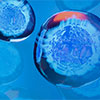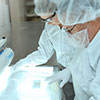BIOTIUM, INC
Supplier:
Biotium
Description:
This MAb reacts with MUC1. The dominant epitope of this MAb has not yet been determined. MUC1 is a large cell surface mucin glycoprotein expressed by most glandular and ductal epithelial cells and some hematopoietic cell lineages. It is expressed on most secretory epithelium, including mammary gland and some hematopoietic cells. It is expressed abundantly in lactating mammary glands and over expressed abundantly in >90% breast carcinomas and metastases. Transgenic MUC1 has been shown to associate with all four c-erbB receptors and localize with c-erbB1 (EGFR) in lactating glands. The MUC1 gene contains seven exons and produces several different alternatively spliced variants. The major expressed form of MUC1 uses all seven exons and is a type 1 transmembrane protein with a large extracellular tandem repeat domain. The tandem repeat domain is highly O glycosylated and alterations in glycosylation have been shown in epithelial cancer cells. Antibody to EMA is useful as a pan-epithelial marker for detecting early metastatic loci of carcinoma in bone marrow or liver.
CF® dyes are Biotium's next-generation fluorescent dyes. CF®647 is a far-red fluorescent dye (Ex/Em 650/665 nm) with excellent brightness. It also is compatible with super-resolution imaging by STORM.
Supplier:
Biotium
Description:
This antibody cocktail recognizes three melanoma-specific proteins, which include MART-1, Tyrosinase and gp100. MART-1 is a newly identified melanocyte differentiation antigen recognized by autologous cytotoxic T lymphocytes. Tyrosinase is one of the targets for cytotoxic T-cell recognition in melanoma patients. The function of gp100 is not known but it is reported to be a useful marker for melanocytes and melanomas. This cocktail of three markers is designed for extremely sensitive labeling of formalin-fixed, paraffin-embedded melanomas and other tumors showing melanocytic differentiation.
Catalog Number:
(89139-328)
Supplier:
Biotium
Description:
Rhodamine-DHPE is a rhodamine-labeled glycerophosphoethanolamine lipid that has been used in membrane fusion assays.
Supplier:
Biotium
Description:
Cyclin B1 Monoclonal antibody, Clone: CCNB1/1098, Host: Mouse, Species reactivity: Mouse, Human, Isotype: IgG1, kappa, Conjugate: CF594, Immunogen: Recom human full-length CCNB1 protein, Synonyms: CCNB, CCNB1, Application: IF, IHC, FC, Size: 500 uL
Supplier:
Biotium
Description:
This antibody recognizes a 66 kDa protein, which is identified as Tripartite motif-containing protein 29 (TRIM29). It interacts with the intermediate filament protein vimentin, a substrate for the PKC family of protein kinases, and with hPKCI-1, an inhibitor of the PKCs. TRIM29 protein contains both zinc finger and leucine zipper motifs, suggesting that the it may form homodimers and possibly associate with DNA. High expression of TRIM29 has been reported in gastric cancer and pancreatic cancer, and correlates with enhanced tumor growth and lymph node metastasis. TRIM29 is also able to distinguish lung squamous cell carcinoma from lung adenocarcinoma with ~90% positive accuracy, when used in a panel with TTF-1, p63, CK5/6, and Napsin-A antibodies.
Supplier:
Biotium
Description:
Myogenin, Monoclonal antibody, Clone: MGN185 + F5D, Host: Mouse, Species reactivity: Pig, Dog, Cat, Rat, Human, Isotype: IgG2a, kappa, Conjugate: purified, Immunogen: Rat myogenin peptide (aa 73-94), recombinant fragment (aa30-224), Synonym:cb553, Size: 500uL
Supplier:
Biotium
Description:
HLA-B belongs to the HLA class I heavy chain paralogues. This class I molecule is a heterodimer consisting of a heavy chain and a light chain (beta-2 microglobulin). The heavy chain is anchored in the membrane. Class I molecules play a central role in the immune system by presenting peptides derived from the endoplasmic reticulum lumen. They are expressed in nearly all cells. The heavy chain is approximately 45 kDa and its gene contains 8 exons. Exon 1 encodes the leader peptide, exon 2 and 3 encode the alpha1 and alpha2 domains, which both bind the peptide, exon 4 encodes the alpha3 domain, exon 5 encodes the transmembrane region and exons 6 and 7 encode the cytoplasmic tail. Polymorphisms within exon 2 and exon 3 are responsible for the peptide binding specificity of each class one molecule. Typing for these polymorphisms is routinely done for bone marrow and kidney transplantation. Hundreds of HLA-B alleles have been described.
CF® dyes are Biotium's next-generation fluorescent dyes. CF®405S is a blue fluorescent dye (Ex/Em 404/431 nm) with superior brightness compared to other blue dyes; it is also compatible with super-resolution imaging by SIM. Note: Conjugates of blue fluorescent dyes are not recommended for detecting low abundance targets, because blue dyes have lower fluorescence and can give higher non-specific background than other dye colors.
Supplier:
Biotium
Description:
This antibody recognizes a protein of 36 kDa, identified as Thymidylate Synthase (TS) (EC 2.1.1.45). TS converts deoxyuridine monophosphate (dUMP) to deoxythymidine monophosphate (dTMP), which is essential for DNA biosynthesis. TS is also a critical target for the fluoropyrimidines, an important group of antineoplastic drugs that are widely used in the treatment of solid tumors. Both 5-FU and fluorodeoxyuridine are converted in tumor cells to FdUMP which inactivates TS by formation of a ternary covalent complex in the presence of the folate cofactor 5,10-methylenetetrahydrofolate. Expression of TS protein is associated with response to 5-fluorouracil (5-FU) in human colorectal, gastric, head and neck, and breast carcinomas.
CF® dyes are Biotium's next-generation fluorescent dyes. CF®647 is a far-red fluorescent dye (Ex/Em 650/665 nm) with excellent brightness. It also is compatible with super-resolution imaging by STORM.
Supplier:
Biotium
Description:
S100 belongs to the family of calcium binding proteins. S100A and S100B proteins are two members of the S100 family. S100A is composed of an alpha and a beta chain whereas S100B is composed of two beta chains. This antibody is specific against an epitope located on the beta-chain (i.e. in S-100A and S-100B) but not on the alpha-chain of S-100 (i.e. in S-100A and S100A0). This antibody can be used to localize S-100A and S-100B in various tissue sections. S-100 protein has been found in normal melanocytes, Langerhans cells, histiocytes, chondrocytes, lipocytes, skeletal and cardiac muscle, Schwann cells, epithelial and myoepithelial cells of the breast, salivary and sweat glands, as well as in glial cells. Neoplasms derived from these cells also express S-100 protein, albeit non-uniformly. A large number of well-differentiated tumors of the salivary gland, adipose and cartilaginous tissue, and Schwann cell-derived tumors express S-100 protein. Almost all malignant melanomas and cases of histiocytosis X are positive for S-100 protein.
CF® dyes are Biotium's next-generation fluorescent dyes. CF®488A is a green fluorescent dye (Ex/Em 490/515 nm) with excellent brightness and photostability. The dye is minimally charged for less non-specific binding. CF®488A also is compatible with super-resolution imaging by TIRF.
Supplier:
Biotium
Description:
Cdc20 Monoclonal antibody, Clone: CDC20/1102, Host: Mouse, Species reactivity: Human, Isotype: IgG1, kappa, Conjugate: biotin, Immunogen: Recombinant human Cdc20 protein, Synonyms: CDC20, CDC20A, p55CDC, P55CDC-LSB, Application: IF, IHC(formalin), FC, Size: 500 uL
Supplier:
Biotium
Description:
This MAb reacts with a reduction-resistant epitope present in both free and SIgA bound Secretory Component. It does not react with the cell lines lacking secretory component. The antibody is useful for studying the distribution and level of both free and bound secretory component. Secretory component is differentially expressed in epithelium, and the antibody is a popular marker for identifying subpopulations of epithelial cells and epithelial differentiation. The Secretory component antibody is a useful research tool for studying mucosal immunity, inflammation, remodeling, differentiation and tumorigenesis, all processes associated with differential secretory component expression.
CF® dyes are Biotium's next-generation fluorescent dyes. CF®568 is a red fluorescent dye (Ex/Em 562/583 nm) with superior brightness and photostability. It also is compatible with super-resolution imaging by STORM and TIRF.
Supplier:
Biotium
Description:
CD6 is a type I transmembrane glycoprotein that contains a 24-amino acid signal sequence, three extracellular scavenger receptor cysteine-rich (SRCR) domains, a membrane-spanning domain and a 44-amino acid cytoplasmic domain. The CD6 glycoprotein is tyrosine phosphorylated during TCR-mediated T cell activation. CD6 shows significant homology to CD5. CD6 is present on mature thymocytes, peripheral T cells and a subset of B cells. Antibodies to CD6 are used to deplete T cells from bone marrow transplants to prevent graft versus host disease.
CF® dyes are Biotium's next-generation fluorescent dyes. CF®647 is a far-red fluorescent dye (Ex/Em 650/665 nm) with excellent brightness. It also is compatible with super-resolution imaging by STORM.
Supplier:
Biotium
Description:
This antibody recognizes a protein of 40 kDa, identified as cytokeratin-19 (CK19), which is expressed in sweat gland, mammary gland ductal and secretory cells, bile ducts, gastrointestinal tract, bladder urothelium, oral epithelia, esophagus, and ectocervical epithelium. Anti-CK19 reacts with a wide variety of epithelial malignancies including adenocarcinomas of the colon, stomach, pancreas, biliary tract, liver, and breast. Perhaps the most useful application is the identification of thyroid carcinoma of the papillary type, although 50%-60% of follicular carcinomas are also labeled. Anti-CK19 is a useful marker for detection of tumor cells in lymph nodes, peripheral blood, bone marrow and breast cancer.
CF® dyes are Biotium's next-generation fluorescent dyes. CF®405S is a blue fluorescent dye (Ex/Em 404/431 nm) with superior brightness compared to other blue dyes; it is also compatible with super-resolution imaging by SIM. Note: Conjugates of blue fluorescent dyes are not recommended for detecting low abundance targets, because blue dyes have lower fluorescence and can give higher non-specific background than other dye colors.
Supplier:
Biotium
Description:
This antibody recognizes a carbohydrate determinant of Gal 1-3(Fuc 1-4) GlcNAc which is blood group antigen Lewis A. It is present primarily on epithelial cells such as colon and kidneys. In the tumors and dedifferentiated tissues, decrease of Lewis A antigen was observed. Lewis A (type 1 chain) is expressed in colonic epithelial cells and may be useful for detection of gastrointestinal tumors, pancreatic cancer, and colorectal tumors. Blood group related antigens represent a group of carbohydrate determinants carried on both glycolipids and glycoproteins. They are usually mucin-type, and are detected on erythrocytes, certain epithelial cells, and in secretions of certain individuals. Sixteen genetically and biosynthetically distinct but inter-related specificities belong to this group of antigens, including A, B, H, Lewis A, Lewis B, Lewis X, Lewis Y, and precursor type 1 chain antigens.
CF® dyes are Biotium's next-generation fluorescent dyes. CF®405S is a blue fluorescent dye (Ex/Em 404/431 nm) with superior brightness compared to other blue dyes; it is also compatible with super-resolution imaging by SIM. Note: Conjugates of blue fluorescent dyes are not recommended for detecting low abundance targets, because blue dyes have lower fluorescence and can give higher non-specific background than other dye colors.
Catalog Number:
(75955-792)
Supplier:
Biotium
Description:
Kappa Light Chain, Monoclonal antibody, Clone: L1C1, Host: Mouse, Species reactivity: Human, Isotype: IgG1, kappa, BSA-free, Immunogen: Purified human Ig kappa chain (HP6053) & Human B-Lymphoma Cells (L1C1), Synonyms: Ig Kappa Chain C Region; IGKC, Size: 50 uL
Supplier:
Biotium
Description:
MITF (microphthalmia transcription factor) is a basic helix-loop-helix-leucine-zipper (bHLH-Zip) transcription factor that regulates the development and survival of melanocytes and retinal pigment epithelium, and also is involved in transcription of pigmentation enzyme genes such as tyrosinase TRP1 and TRP2. MITF has been shown to be phosphorylated by MAP kinase in response to c-kit activation, resulting in upregulation of MITF transcriptional activity. Mutations of the MITF gene are associated with the autosomal dominant hereditary deafness and pigmentation condition, Waardenburg Syndrome type 2A. Multiple isoforms of MITF exist, including MITF-A, MITF-B, MITF-C, MITF-H, and MITF-M, which differ in the amino-terminal domain and in their expression patterns. The MITF-M isoform is restricted to the melanocyte cell lineage. This MAb recognizes a nuclear protein, which is expressed in the majority of primary and metastatic epithelioid malignant melanomas as well as in normal melanocytes, benign nevi and dysplastic nevi.
CF® dyes are Biotium's next-generation fluorescent dyes. CF®405S is a blue fluorescent dye (Ex/Em 404/431 nm) with superior brightness compared to other blue dyes; it is also compatible with super-resolution imaging by SIM. Note: Conjugates of blue fluorescent dyes are not recommended for detecting low abundance targets, because blue dyes have lower fluorescence and can give higher non-specific background than other dye colors.
Inquire for Price
Stock for this item is limited, but may be available in a warehouse close to you. Please make sure that you are logged in to the site so that available stock can be displayed. If the
Stock for this item is limited, but may be available in a warehouse close to you. Please make sure that you are logged in to the site so that available stock can be displayed. If the
You must log in to order restricted items. We request that you provide the required business documentation to purchase this product for the first time.
To order chemicals, medical devices, or other restricted products please provide identification that includes your business name and shipping address via email CMD_NA@vwr.com or fax 484.881.5997 referencing your VWR account number . Acceptable forms of identification are:
-Additional Documentation May be needed to purchase this item. A VWR representative will contact you if needed.
This product has been blocked by your organization. Please contact your purchasing department for more information.
The original product is no longer available. The replacement shown is available.
This product is currently unavailable but limited stock may be available in our extended warehouse network. Please call 1-800-932-5000 and a VWR Customer Service Representative will help you.
|
|||||||||


































